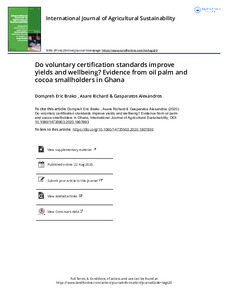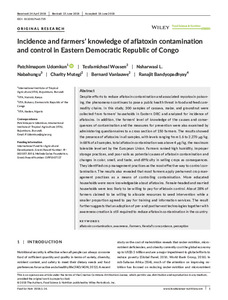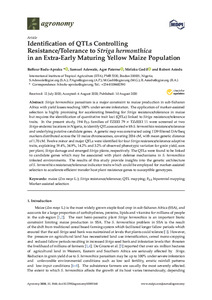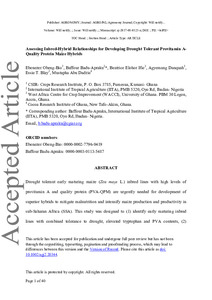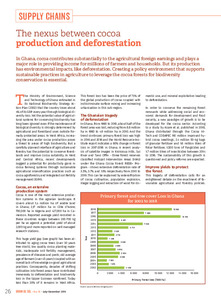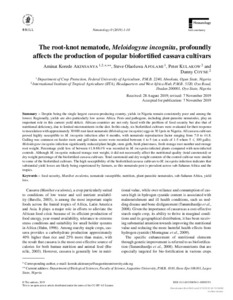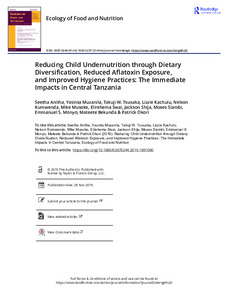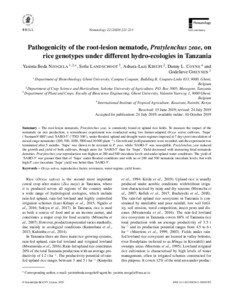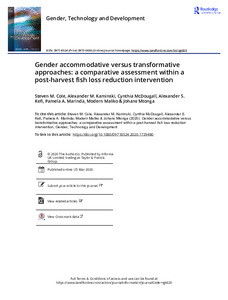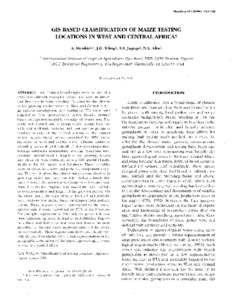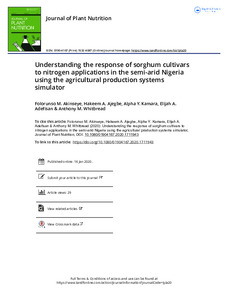Welcome to the International Institute of Tropical Agriculture Research Repository
Journal and Journal Articles: Recent submissions
Now showing items 601-620 of 5157
-
Multi-stakeholder process strengthens agricultural innovations and sustainable livelihoods of farmers in southern Nigeria
(2018)Purpose: In this paper, we explore the strategic role of Multi-stakeholder processes (MSP) in agricultural innovations and how it has impacted livelihood assets’ (LAs) capital dynamics of stakeholders in platforms in West Africa. Design/Methodology/Approach: We demonstrate how LA capitals and socio-economic dynamics induced by MSP can enhance cassava production efficiency but also create opportunities and challenges that influence platform dynamics and impacts. We use a multistage sampling ... -
The atoxigenic biocontrol product Aflasafe SN01 is a valuable tool to mitigate aflatoxin contamination of both maize and groundnut cultivated in Senegal
(2020-02)Aflatoxin contamination of groundnut and maize infected by Aspergillus section Flavi fungi is common throughout Senegal. The use of biocontrol products containing atoxigenic Aspergillus flavus strains to reduce crop aflatoxin content has been successful in several regions, but no such products are available in Senegal. The biocontrol product Aflasafe SN01 was developed for use in Senegal. The four active ingredients of Aflasafe SN01 are atoxigenic A. flavus genotypes native to Senegal and distinct ... -
Actor diversity and interactions in the development of banana hybrid varieties in Uganda: implications for technology uptake
(2018)Purpose: We examine the nature of networks through which new hybrid banana varieties (HBVs) in Uganda are developed, and how different actors engage in the technology development process. Design/methodology/approach: We collected the data through 20 key informant interviews and 5 focus group discussions with actors involved in the process. We analysed the data with NVivo and Social Network Analysis software. Findings: The process of developing HBVs involves many actors with a diversity ... -
Do voluntary certification standards improve yields and wellbeing? Evidence from oil palm and cocoa smallholders in Ghana
(2020-08-22)Cocoa and oil palm production are major agricultural activities in Ghana, contributing substantially to the national economy and rural livelihoods. Even though smallholders produce practically all cocoa and a large fraction of oil palm in Ghana, their production is currently characterized by low yields and negative environmental and socioeconomic outcomes. Different certification standards have been promoted to enhance oil palm and cocoa sustainability in Ghana. This paper assesses the impact of ... -
Incidence and farmers' knowledge of aflatoxin contamination and control in eastern Democratic Republic of Congo
(2018-09)Despite efforts to reduce aflatoxin contamination and associated mycotoxin poisoning, the phenomenon continues to pose a public health threat in food and feed commodity chains. In this study, 300 samples of cassava, maize, and groundnut were collected from farmers’ households in Eastern DRC and analyzed for incidence of aflatoxins. In addition, the farmers’ level of knowledge of the causes and consequences of contamination and the measures for prevention were also examined by administering ... -
Identification of QTLs controlling resistance/tolerance to Striga hermonthica in an extra-early maturing yellow maize population
(2020-08-10)Striga hermonthica parasitism is a major constraint to maize production in sub-Saharan Africa with yield losses reaching 100% under severe infestation. The application of marker-assisted selection is highly promising for accelerating breeding for Striga resistance/tolerance in maize but requires the identification of quantitative trait loci (QTLs) linked to Striga resistance/tolerance traits. In the present study, 194 F2:3 families of TZEEI 79 × TZdEEI 11 were screened at two Striga-endemic locations ... -
Assessing inbred-hybrid relationships for developing drought tolerant provitamin A - quality protein maize hybrids
(2020-09-10)Drought tolerant early maturing maize (Zea mays L.) inbred lines with high levels of provitamin A and quality protein (PVA‐QPM) are urgently needed for development of superior hybrids to mitigate malnutrition and intensify maize production and productivity in sub‐Saharan Africa (SSA). This study was designed to (1) identify early maturing inbred lines with combined tolerance to drought, elevated tryptophan and PVA contents, (2) examine inbred‐hybrid relationships for tryptophan and PVA accumulation, ... -
Genetic diversity among early provitamin A quality protein maize inbred lines and the performance of derived hybrids under contrasting nitrogen environments
(2020-07-18)Information on population structure and genetic diversity of germplasm in a breeding programme is useful because it enhances judicious utilisation of genetic resources to achieve breeding objectives. Seventy early maturing provitamin A (PVA) quality protein maize (QPM) inbreds developed by the IITA- maize improvement programme were genotyped using 8171 DArTseq markers. Furthermore, 96 hybrids derived from 24 selected inbreds plus four checks were evaluated under low-N and optimal environments in ... -
Transitioning European protein-rich food consumption and production towards more sustainable patterns-strategies and policy suggestions
(2020-03-04)Global and European diets have shifted towards greater consumption of animal proteins. Recent studies urge reversals of these trends and call for a rapid transition towards adoption of more plant-based diets. This paper explored mechanisms to increase the production and consumption of plant-proteins in Europe by 2030, using participatory backcasting. We identified pathways to the future (strategies), as well as interim milestones, barriers, opportunities and actions, with key European stakeholders ... -
The nexus between cocoa production and deforestation
(2019)In Ghana, cocoa contributes substantially to the agricultural foreign earnings and plays a major role in providing income for millions of farmers and households. But its production has environmental impacts, like deforestation. Creating a policy environment that supports sustainable practices in agriculture to leverage the cocoa forests for biodiversity conservation is essential. -
The root-knot nematode, Meloidogyne incognita, profoundly affects the production of popular biofortified cassava cultivars
(2020-07-14)Despite being the single largest cassava-producing country, yields in Nigeria remain consistently poor and among the lowest. Regionally, yields are also particularly low across Africa. Pests and pathogens, including plant-parasitic nematodes, play an important role in this current yield deficit. African countries are not only faced with the problem of food security but also that of nutritional deficiency, due to limited micronutrients in the diet. In this study, six biofortified cultivars were ... -
Reducing child undernutrition through dietary diversification, reduced aflatoxin exposure, and improved hygiene practices: the immediate impacts in central Tanzania
(2019-11-28)The study aimed to quantify the immediate effects of dietary diversification, food safety, and hygiene interventions on child undernutrition in four rural villages in Kongwa district of central Tanzania. One hundred mothers with their children of less than 24 months old were recruited for this study. The difference-in-difference (DID) method was used to assess the effects of intensive intervention through a learning-by-doing process on the topic of aflatoxin free diversified food utilization and ... -
Seed dressing maize with imazapyr to control Striga hermonthica in farmers’ fields in the
(2020-03-17)Use of small doses of imazapyr and pyrithiobac for seed coatings of imazapyr-resistant maize hybrids (IR-Maize) offers an effective means to control Striga hermonthica. Field trials were conducted in Bauchi and Kano States of Nigeria in 2014 and 2015 under heavy Striga infestation to evaluate the potential effectiveness of herbicide coated hybrids maize on Striga control in farmers’ field. Results showed that herbicide coated seeds reduced number of emerged Striga per m2 and Striga damage symptoms ... -
Production of banana bunchy top virus (BBTV)-free plantain plants by in vitro culture
(2020-03)Banana Bunchy Top Disease (BBTD) caused by the Banana Bunchy Top Virus (BBTV) is one of the most important banana diseases in the Democratic Republic of Congo. This study focused on the production of BBTV-free plantain seedlings from infected banana plants. A total of 10 suckers from the French plantain Litete (Musa AAB) and the False Horn plantain Libanga Likale (Musa AAB) with advanced BBTD symptoms were collected. Meristematic apices excised from those suckers were cultured in vitro and subcultured ... -
Pathogenicity of the root-lesion nematode, pratylenchus zeae, on rice genotypes under different hydro-ecologies in Tanzania
(2020)The root-lesion nematode, Pratylenchus zeae, is commonly found in upland rice fields. To measure the impact of the nematode on rice production, a screenhouse experiment was conducted using two farmer-adapted Oryza sativa cultivars, ‘Supa’ (‘SurinamV-880’) and ‘SARO-5’ (‘TXD 306’), under flooded, upland and drought water regimes imposed at 7 days post-inoculation of mixed-stage nematodes (200, 500, 1000, 3000 and 10 000 plant−1). Growth and yield parameters were recorded, and the experiment was ... -
Gender accommodative versus transformative approaches: a comparative assessment within a post-harvest fish loss reduction intervention
(2020-03-25)Technical and social constraints limit value chain actors from equitably engaging in and benefiting from capture fisheries in low-income settings. Extension and development programs often focus on the former, which reflects a technocratic orientation of the fisheries sector and uncertainty about effective ways for development programs to engage with gender and other social constraints. This study presents empirical insights that address these challenges to fisheries development. The study took ... -
Free-living nematode assemblages in the rhizosphere of watermelon plants in Nigeria: a baseline study
(2020)Watermelon is increasingly produced and consumed in Nigeria and sub-Saharan Africa. However, limited information exists regarding nematode pests and beneficial/free-living nematodes associated with the crop. The present study recorded the abundance and diversity of free-living nematodes from 50 watermelon fields across south-west Nigeria during 2016/2017. Of the 30 genera identified from soil samples, Cephalobus, followed by Rhabditis, Aphelenchus and Aporcelaimus, were predominant. Variation in ... -
Extruded flakes from pearl millet (Pennisetum glaucum)-carrot (Daucus carota) blended flours-production, nutritional and sensory attributes
(2020)Millet flour (M) and carrot flour(C) were produced and blended in the ratios 100M:0C, 95M:5C, 90M:10C, 85M:15C and 80M:20C respectively to produce extruded flakes. The composite flours were subjected to analysis of the proximate and mineral composition, as well as functional and pasting properties. Extruded flakes were analyzed for proximate composition, total carotenoids, colour and sensory evaluation. There was no significant difference (p > 0.05) in the proximate, functional and pasting properties ... -
GIS based classification of maize testing locations in West and Central Africa
(2000)Stratifying a broad target growing area of a crop into different ecological zones has been an important first step in plant breeding. To cater for the diverse maize growing environments in West and Central Africa, germplasm development and testing at IITA have been targeted to four agroecological zones broadly defined based on experiences and knowledge of researchers. This study was carried out to group maize testing locations with similar climatic features, and then use the groups to produce a ... -
Understanding the response of sorghum cultivars to nitrogen applications in the semi-arid Nigeria using the agricultural production systems simulator
(2020-01-16)The Agricultural Production Systems simulator (APSIM) model was calibrated and evaluated using two improved sorghum varieties conducted in an experiment designed in a randomized complete block, 2014–2016 at two research stations in Nigeria. The results show that the model replicated the observed yield accounting for yield differences and variations in phenological development between the two sorghum cultivars. For early-maturing cultivar (ICSV-400), the model indicated by low accuracy with root ...



